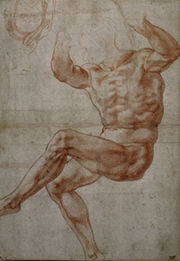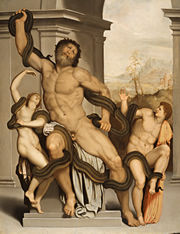"De Raphaël à Carracci. L’art de la Rome pontificale" @ National Gallery of Canada (NGC)
Raphael (1483–1520), Portrait of Bindo Altoviti, c. 1515, Oil on panel, 59.7 × 43.8 cm. Samuel H. Kress Collection. Image courtesy of the Board of Trustees of the National Gallery of Art, Washington
OTTAWA.- The power, politics and drama that surrounded papal patronage in 16th-century Rome will be revealed in a magnificent new exhibition opening at the National Gallery of Canada (NGC) on May 29. From Raphael to Carracci: The Art of Papal Rome represents an unprecedented survey of art in this period. Presented by Sun Life Financial, it will be on view until September 7, 2009.
This large international loan exhibition brings together over 150 exceptional paintings and drawings for the first time by celebrated artists such as Michelangelo, Titian, El Greco, Vasari, Barocci and Annibale Carracci. In addition, pieces by lesser known, but nonetheless superb artists are also included. They too played a significant role in the evolution of Renaissance Rome but have only recently been acknowledged and appreciated for their skill and relevance to art history during this period. Together they illustrate how papal patronage, which was driven by unrivalled ambition and the need to propagate their own belief system, gave rise to one of the richest periods in art history and the lasting legacy of some of the greatest artists in the world.
“An exhibition of this exceptional nature could not have been realized without the generosity and vision of institutional and individual lenders,” said NGC Director, Marc Mayer. “The vast majority of these works have been generously loaned to us by prestigious arts institutions and individual collectors throughout Europe and North America. Given their rarity, the Gallery is privileged to be the sole venue for this exhibition.”
Papal patronage raises Rome to an unrivalled cultural capital - Organized chronologically pope by pope, the exhibition commences with Julius II in 1503 and concludes with Clement VIII in 1606. Through their enlightened patronage they transformed Rome from a banal backwater to the most important and influential centre of the Renaissance and the unrivalled cultural capital of the western world for over three centuries. By the same token, it shows Rome as an unpredictable European centre, deeply affected by the dramatically shifting tides of this patronage and the tensions created between the temporal and spiritual worlds.
“Even more than Michelangelo, Raphael exemplifies a new type of artist that developed Rome in this period,” said NGC Deputy Director and exhibition curator, David Franklin. “However, another purpose of this exhibition is to present Raphael’s ideal and elegant style as a source of inspiration to his many talented followers, as well as to portray him as a liberated master who gave birth to a seemingly endless variety of artistic forms. By concluding with the works of Annibale Carracci, we intend to examine more broadly the transitions of style known as High Renaissance, Mannerism and the Early Baroque, and indeed to question the relevance of these terminologies.”
The NGC acknowledges with gratitude the generosity of the presenting sponsor, Sun Life Financial, for their support of From Raphael to Carracci: The Art of Papal Rome. Sun Life, a long-standing partner of the National Gallery, has sponsored three major exhibitions since 2006.
“Thanks to the National Gallery of Canada, we now have a rare opportunity to see an extraordinary collection of timeless masterpieces by some of the greatest artists of the 16th-century,” said Sun Life Financial Chief Executive Officer, Donald A. Stewart. “As presenting sponsor of this exhibit and a long-standing supporter of the arts in Canada, Sun Life Financial is pleased to help the National Gallery provide Canadians of all ages a glimpse into the fascinating world and art of Papal Rome.”
Strengthening the Gallery’s European Collections - From Raphael to Carracci: The Art of Papal Rome is also a testament to the increasing strength of the National Gallery’s own collection of European art as this exhibition will feature 25 of its own pieces. These include a number of recent acquisitions, such as the remarkable work by Francesco Salviati Virgin and Child with Angel that was purchased in 2005 through the support of the NGC Volunteers Circle and the patrons of the NGC Foundation. Also displayed will be an oil sketch by Cristoforo Roncalli for his Saint Peter’s altarpiece entitled Death of Sapphira – a subject famously treated by Raphael.
From Raphael to Carracci: The Art of Papal Rome is designed as a sequel to the NGC’s exhibition entitled Renaissance Florence shown in Ottawa in 2005. The organizing committee, led by David Franklin, also includes distinguished art historians, including Rhoda Eitel-Porter of the Morgan Library & Museum, Sebastian Schütze of Queen’s University and Louis A. Waldman from the University of Texas.
The National Gallery of Canada extends special thanks to its partners - The National Gallery of Canada praises its partners for their support: Alenia North America, for the restoration of the St-Julian Hospitaller painting, featured in this exhibition; the Italian Embassy and the Italian Chamber of Commerce in Canada for the presentation of a private baroque concert from the Accademia Barocca di Santa Cecilia di Roma; the Canada Travelling Exhibition Indemnification Program through the Department of Canadian Heritage, as well as its media partners, la Télévision de Radio-Canada, CBC Television, The Ottawa Citizen and Le Droit.
Catalogue - A fully-illustrated 480-page catalogue, produced by the National Gallery of Canada, accompanies this exhibition. Featuring 378 illustrations and published in English and French, it is co-authored by David Franklin, NGC Deputy Director and Chief Curator, Ingrid D. Rowland, author of The Culture of the High Renaissance (Cambridge), Sebastian Schütze, Professor of Art History and Bader Chair in Southern Baroque Art, Department of Art at Queen’s University, and Carlo Gasparri, Professor of Archeology at the University of Naples. Contributions have also been made by more than 40 international scholars. Appearing in hardcover only at a cost of $75.00 (CDN) it is on sale at the National Gallery of Canada Bookstore or online.
Carlo Saraceni (c. 1580–1620), Venus and Mars, c. 1600, Oil on copper, Carmen Thyssen-Bornemisza Collection, on loan at the Thyssen-Bornemisza Museum, Madrid
 De nombreuses expositions ont célébré l’art de la Renaissance florentine et vénitienne, mais rarement a-t-on traité de la période du xvie siècle. La tenue, en dehors de Rome, d’expositions de cette envergure sur l’une ou l’autre des facettes de ce sujet constitue donc un fait particulièrement rare, en dépit de son rôle central dans l’histoire de l’art. Certains des noms les plus illustres de l’histoire de l’art, dont Raphaël, Michel-Ange, Salviati, Vasari et Barocci, étaient actifs à Rome à cette époque, et ils ont une place de choix dans cette exposition qui se conclut avec le non moins innovateur Annibale Carracci.
De nombreuses expositions ont célébré l’art de la Renaissance florentine et vénitienne, mais rarement a-t-on traité de la période du xvie siècle. La tenue, en dehors de Rome, d’expositions de cette envergure sur l’une ou l’autre des facettes de ce sujet constitue donc un fait particulièrement rare, en dépit de son rôle central dans l’histoire de l’art. Certains des noms les plus illustres de l’histoire de l’art, dont Raphaël, Michel-Ange, Salviati, Vasari et Barocci, étaient actifs à Rome à cette époque, et ils ont une place de choix dans cette exposition qui se conclut avec le non moins innovateur Annibale Carracci.
 L’exposition explore la Rome de la Renaissance à travers un ensemble de tableaux et dessins sélectionnés avec soin, qui ont été créés durant une période particulièrement féconde et mouvementée de l’histoire culturelle ayant pour toile de fond l’histoire des papes. Suivant un parcours chronologique axé sur les pontificats de Jules II à Clément VIII, l’exposition adopte une approche linéaire qui révèle, de façon paradoxale, la remarquable diversité et la grande richesse des œuvres produites grâce à un type unique de mécénat.
L’exposition explore la Rome de la Renaissance à travers un ensemble de tableaux et dessins sélectionnés avec soin, qui ont été créés durant une période particulièrement féconde et mouvementée de l’histoire culturelle ayant pour toile de fond l’histoire des papes. Suivant un parcours chronologique axé sur les pontificats de Jules II à Clément VIII, l’exposition adopte une approche linéaire qui révèle, de façon paradoxale, la remarquable diversité et la grande richesse des œuvres produites grâce à un type unique de mécénat.
 De Raphaël à Carracci. L’art de la Rome pontificale explore et met en lumière les innovations apportées par des géants tels que Raphaël et Michel-Ange, et montre aussi l’influence qu’ils ont exercée sur plusieurs autres artistes brillants et fascinants, jusqu’à Annibale Caracci — un maître dont le génie se comparait à celui de ses plus illustres contemporains. Cette époque est souvent appelée Haute Renaissance, maniérisme ou début du baroque, mais l’exposition, qui présente des œuvres issues de ces trois périodes de référence, nous permet d’apprécier les artistes pour ce qu’ils sont, sans idées préconçues. Le public aura aussi l’occasion de découvrir plusieurs nouveaux artistes aux styles extrêmement inventifs et raffinés.
De Raphaël à Carracci. L’art de la Rome pontificale explore et met en lumière les innovations apportées par des géants tels que Raphaël et Michel-Ange, et montre aussi l’influence qu’ils ont exercée sur plusieurs autres artistes brillants et fascinants, jusqu’à Annibale Caracci — un maître dont le génie se comparait à celui de ses plus illustres contemporains. Cette époque est souvent appelée Haute Renaissance, maniérisme ou début du baroque, mais l’exposition, qui présente des œuvres issues de ces trois périodes de référence, nous permet d’apprécier les artistes pour ce qu’ils sont, sans idées préconçues. Le public aura aussi l’occasion de découvrir plusieurs nouveaux artistes aux styles extrêmement inventifs et raffinés.
Plus de 70 artistes sont représentés dans l’exposition De Raphaël à Carracci. L'art de la Rome pontificale. Découvrez ici les particularités des plus connus. Raphaël (1483 - 1520). L’un des grands peintres de la Renaissance, Raphaël réinterprète l’art du XVe siècle par son étude de l’art contemporain et de l’art de la Rome classique. Imprégnés de grâce et d’harmonie, ses œuvres demeurent parmi les plus appréciées de la Renaissance. Michel-Ange (1475 - 1564). Michel-Ange est l’archétype même de l’artiste comme génie tourmenté. Ses oeuvres originales et exceptionnellement puissantes présentent souvent des hommes et des femmes à la force héroïque. Il demeure l’un des artistes les plus admirés et les plus influents de l’histoire. Giorgio Vasari (1511 - 1574). Vasari dirige des équipes d’auxiliaires pour réaliser des décors à grande échelle et assemble une magnifique collection de dessins d’artistes. Son étude critique de l’art et de l’architecture, Les vies des meilleurs peintres, sculpteurs et architectes, est considérée comme le fondement de l’histoire de l’art moderne. Francesco Salviati (1510 - 1563). Dans ses fresques, Salviati peint tantôt des scènes d’action complexes débordantes de personnages, tantôt de délicates fantaisies architecturales dans le style Rome ancienne. Il crée également des tableaux, des portraits très soignés et des motifs de tapisserie et d’orfèvrerie. Federico Barocci (1528 - 1612). Barocci est généralement considéré comme le plus grand peintre de son temps en Italie centrale. Les particularités de son œuvre – son traitement de l’espace et son goût pour les draperies ondoyantes – s’insèrent parfaitement dans la tradition maniériste qui dépeint les personnages de façon à rehausser l’effet dramatique de la scène. Annibale Carracci (1560 - 1609). Annibale Carracci ouvre un atelier de peinture avec son frère Agostino et son cousin Ludovico Carracci. Alors que les Carracci mettent l'accent sur le dessin linéaire typiquement florentin, leur style découle également des peintres vénitiens, c’est-à-dire une attention particulière aux couleurs scintillantes et aux contours estompés des objets.

/https%3A%2F%2Fprofilepics.canalblog.com%2Fprofilepics%2F1%2F0%2F100183.jpg)




/http%3A%2F%2Fstorage.canalblog.com%2F15%2F66%2F577050%2F55574283_o.jpg)
/http%3A%2F%2Fstorage.canalblog.com%2F51%2F95%2F119589%2F52772885_p.jpg)
/http%3A%2F%2Fstorage.canalblog.com%2F14%2F42%2F577050%2F51183238_o.jpg)
/http%3A%2F%2Fstorage.canalblog.com%2F60%2F09%2F577050%2F49884144_o.jpg)